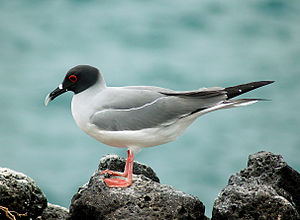Swallow-tailed gull
| Swallow-tailed gull | |
|---|---|
 |
|
| On the Galápagos Islands | |
| Scientific classification | |
| Kingdom: | Animalia |
| Phylum: | Chordata |
| Class: | Aves |
| Order: | Charadriiformes |
| Family: | Laridae |
| Genus: |
Creagrus Bonaparte, 1854 |
| Species: | C. furcatus |
| Binomial name | |
|
Creagrus furcatus (Neboux, 1846) |
|
The swallow-tailed gull (Creagrus furcatus) is an equatorial seabird in the gull family, Laridae. It is the only species in the genus Creagrus, which derives from the Latin Creagra and the Greek kreourgos which means butcher, also from kreas, meat; according to Jobling it would mean "hook for meat" referring to the hooked bill of this species. It was first described by French naturalist and surgeon Adolphe-Simon Neboux in 1846. Its scientific name is originally derived from the Greek word for gull, "Glaros" and via Latin Larus, "gull" and furca "two-tined fork". It spends most of its life flying and hunting over the open ocean. The main breeding location is in the Galápagos Islands, particularly the rocky shores and cliffs of Hood, Tower and Wolf Islands, with lower numbers on most of the other islands. It is more common on the eastern islands where the water is warmer.
It is the only fully nocturnal gull and seabird in the world, preying on squid and small fish which rise to the surface at night to feed on plankton.
The swallow-tailed gull has no structural or plumage differences between the male and female. In the breeding season, the adult has a black plumaged head and a bright red fleshy rim around each eye. Outside the breeding season, the head is white and the eye rim becomes black. It has a grayish upper breast, gray mantle, and black wingtips. The mostly black bill has a contrasting white tip.
The swallow-tailed gull is a near-endemic breeding bird of the Galápagos Islands, although a few pairs nest on Malpelo Island off the coast of Colombia. When not breeding, it is totally pelagic, flying and hunting over the open oceans, and migrating eastward to the coasts of Ecuador and Peru.
...
Wikipedia

